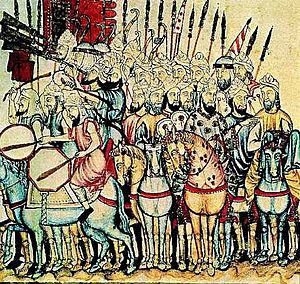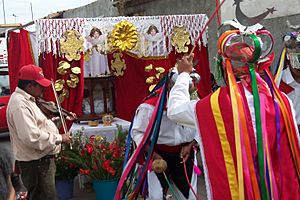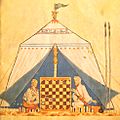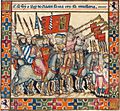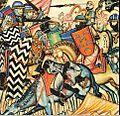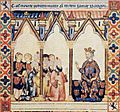Moors facts for kids
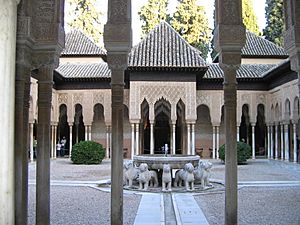
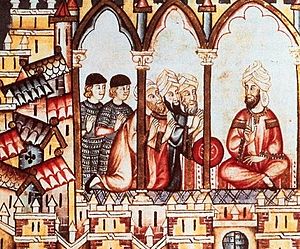
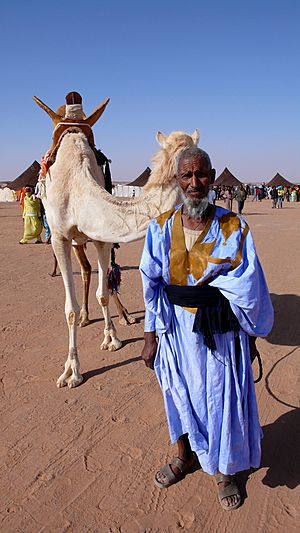
The Moors were the Muslim inhabitants who lived on the Iberian Peninsula and North Africa in the Middle Ages. In Europe, the word is very often used to talk about people whose ancestors were North African.
The Moors (Umayyad Muslims) came from North Africa and were initially of Berber ancestry. Many of them came to what is now Spain and Portugal. They had a very big influence on the culture of these countries.
The Moors were the ones who captured Al Andalus and named it Al Andalus, which means land of the vandals.
Origins of the name
The name derives from the old Berber tribe of the Mauri and their kingdom, Mauretania, which became a Roman province after its last king Bocchus II willed it to Octavian in 33 BC. Mauretania lay in present day Morocco and Western Algeria. The name of Mauri was applied by the Romans to all Africa natives of North Africa still ruled by their own chiefs, until the 3rd century AD.
Moorish Empire
In AD 711, some Moors, in fact Arabs and Berbers, invaded Visigoth Christian Spain. Under their Berber leader Tariq ibn-Ziyad, they landed at Gibraltar on April 30 and brought most of the Iberian Peninsula under Islamic Sharia rule in an eight-year campaign. They attempted to move northeast across the Pyrenees Mountains but were defeated by the Christian Frank Charles Martel at the Battle of Tours in 732. The Moors ruled in Spain and Portugal, except for small areas in the northwest and largely Basque regions in the Pyrenees, and in North Africa for several decades. The Moorish state suffered civil conflict in the 750s.
The country then broke up into a number of mostly Islamic fiefdoms, which were consolidated under the Caliphate of Cordoba. Christian states based in the north and west slowly extended their power over Spain. Galicia, León, Navarre, Aragon, Catalonia or Marca Hispanica, Portugal and Castile became Christian again in the next several centuries.
In 1212 a coalition of Christian kings under the leadership of Alfonso VIII of Castile drove the Muslims from Central Spain. However the Moorish Kingdom of Granada thrived for three more centuries. This kingdom is known in modern times for such architectural gems as the Alhambra.
On January 2 1492, Boabdil, the leader of the last Muslim stronghold in Granada surrendered to armies of a recently united Christian Spain. The remaining Muslims were forced to leave Spain or convert to Christianity. These descendants of the Muslims were named moriscos. They were an important part of the peasantry in some territories, like Aragon, Valencia, and Andalusia, until their systematic expulsion in the years from 1609 to 1614. It's estimated that this affected 300,000 out of a total of 8 million inhabitants at the time. The expelled Moors mostly went to Morocco, Algeria, and Tunisia, and helped to develop their culture; others became corsairs; a significant number of them in Andalusia joined the Gypsies who were entering the country at that time, passing off as Gypsies themselves instead being forced to leave their homeland. This mix of cultures gave birth to [Flamenco] music (Arabic: Fellah Mengu, peasant without land).
Present-day Moors
In modern usage, Moor or Moorish (Spanish: moro, French: maure) is used to designate West African people whose native tongue is the Hassaniya dialect of Arabic. Moors live mainly in Western Sahara and the Islamic Republic of Mauritania, the latter of which has got its name from them, too. There are also significant Hassaniya-speaking communities in Mali and Senegal.
Ethnically, the Moors are divided into two main groups: White Moors and Black Moors. White Moors (Arabic: البيضان, transliterated: al-bīḍānī) are nomads of Arabo-Berber origin with relatively fair skin colour. Black Moors (Arabic: السودان) are generally considered to stem from former enslaved populations of White Moors who have adopted the customs and language of their masters. Nowadays, slavery being officially abolished, most Black Moors live an independent life, although some say underprivileged and repressed. Still according to some reports, slavery does exist in some parts of Mauritania, at least. The Black Moors do not identify themselves with other black population of their home countries, even significant ones.
Images for kids
-
Christian and Moor playing chess, from The Book of Games of Alfonso X, c. 1285
-
A figure of a Moor being trampled by a conquistador's horse at the National Museum of the Viceroyalty in Tepotzotlan.
-
Moros y Cristianos festival in Oliva.
-
The Great Mosque of Kairouan was founded by the Arab general Uqba ibn Nafi in 670 during the Islamic conquest, to provide a place of worship for recently converted or immigrating Muslims.
-
This is a large mural located on the ceiling of the Hall of Kings of the Alhambra which possibly depicts the first ten sultans of the Nasrid dynasty. It is a late-14th-century Gothic painting by a Christian Toledan artist.
-
Depiction of the Moors in Iberia, from The Cantigas de Santa Maria
-
Moorish army (right) of Almanzor during the Reconquista Battle of San Esteban de Gormaz, from Cantigas de Alfonso X el Sabio
-
The Moors request permission from James I of Aragón
-
Muslim musicians at the court of the Norman King Roger II of Sicily
-
Interior of the Mosque–Cathedral of Córdoba
-
Arms of the wealthy Bristol merchant and shipper William II Canynges (d.1474), as depicted on his canopied tomb in St Mary Redcliffe Church, showing the couped heads of three Moors wreathed at the temples
-
Averroes, a Moorish polymath, was the founder of the Averroism school of philosophy, and influential in the rise of secular thought in Western Europe. Painted by Andrea Bonaiuto in 14th century
-
Leo Africanus, born in Granada
See also
 In Spanish: Moro para niños
In Spanish: Moro para niños



